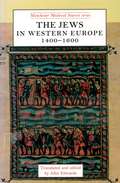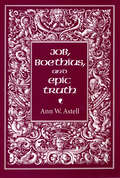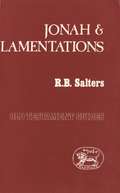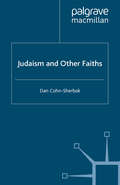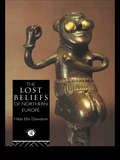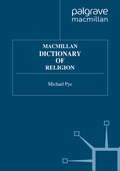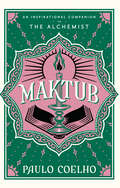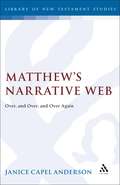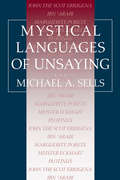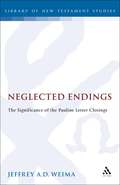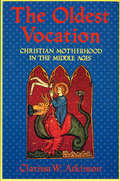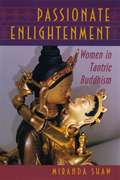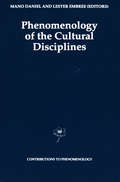- Table View
- List View
Jewish Christians and Christian Jews: From the Renaissance to the Enlightenment (International Archives of the History of Ideas Archives internationales d'histoire des idées #138)
by Gordon M. Weiner Richard H. PopkinThe appearance of religious toleration combined with the intensification of the search for theological truth led to a unique phenomenon in early modern Europe: Jewish Christians and Christian Jews. These essays will demonstrate that the cross-fertilization of these two religions, which for so long had a tradition of hostility towards each other, not only affected developments within the two groups but in many ways foreshadowed the emergence of the Enlightenment and the evolution of modern religious freedom.
The Jews in western Europe, 1400–1600 (Manchester Medieval Sources)
by John EdwardsAs European politics, society, economy and religion underwent epoch-making changes between 1400 and 1600, the treatment of Europe's Jews by the non-Jewish majority was, then as in later periods, a symptom of social problems and tensions in the Continent as a whole. Through a broad-ranging collection of documents, John Edwards sets out to present a vivid picture of the Jewish presence in European life during this vital and turbulent period. Subjects covered include the Jews' own economic presence and culture, social relations between Jews and Christians, the policies and actions of Christian authorities in Church and State. He also draws upon original source material to convey ordinary people's prejudices about Jews, including myths about Jewish 'devilishness', money-grabbing, and 'ritual murder' of Christian children. Full introductory and explanatory material makes accessible the historical context of the subject and highlights the insights offered by the documents as well as the pitfalls to be avoided in this area of historical enquiry. This volume aims to provide a coherent working collection of texts for lecturers, teachers and students who wish to understand the experience of Jewish Europeans in this period.
The Jews of Moscow, Kiev and Minsk: Identity, Antisemitism, Emigration
by Robert J. Brym Rozalina RyvkinaThe persecution and flight of Jews from the former Soviet Union have been in the news for 25 years yet surprisingly little exact information is available on them. Various parties have offered widely differing assessments of how many Jews live in the region, how persecuted they are, how strongly they identify as Jews, their prospects for cultural revival, how likely it is that those who remain will soon leave, and the probable destinations of those who emigrate. This book sheds light on all these questions. It is based on the first survey of a large, representative sample of CIS Jews, conducted in 1993 in Moscow, Kiev and Minsk by acknowledged Western and Russian experts. Many of its findings are surprising. It is the definitive sociological study of Jews in the Slavic republics of the CIS to date.
Job, Boethius, and Epic Truth
by Ann W. AstellCalling into question the common assumption that the Middle Ages produced no secondary epics, Ann W. Astell here revises a key chapter in literary history. She examines the connections between the Book of Job and Boethius' s Consolation of Philosophy—texts closely associated with each other in the minds of medieval readers and writers—and demonstrates that these two works served as a conduit for the tradition of heroic poetry from antiquity through the Middle Ages and into the Renaissance. As she traces the complex influences of classical and biblical texts on vernacular literature, Astell offers provocative readings of works by Dante, Chaucer, Spenser, Malory, Milton, and many others.Astell looks at the relationship between the historical reception of the epic and successive imitative forms, showing how Boethius's Consolation and Johan biblical commentaries echo the allegorical treatment of" epic truth" in the poems of Homer and Virgil, and how in turn many works classified as "romance" take Job and Boethius as their models. She considers the influences of Job and Boethius on hagiographic romance, as exemplified by the stories of Eustace, Custance, and Griselda; on the amatory romances of Abelard and Heloise, Dante and Beatrice, and Troilus and Criseyde; and on the chivalric romances of Martin of Tours, Galahad, Lancelot, and Redcrosse. Finally, she explores an encyclopedic array of interpretations of Job and Boethius in Milton's Paradise Lost, Paradise Regained, and Samson Agonistes.
Jonah and Lamentations (Old Testament Guides)
by R. B. SaltersWhile the book of Jonah is, in some ways, unique, it stands firmly in the Old Testament tradition. There have been various suggestions as to genre, the most likely being the (short) didactic story; but the aim of the author is not easy to discern. The authenticity of Jonah's message to the Ninevites is stressed, as is their repentance, and Yahweh's mercy. The purpose of the book must lie in a combination of these themes. Lamentations is a neglected book, perhaps because it was associated with the book of Jeremiah and considered almost as an appendix. On the question of genre it has the closest affinities with the psalms of lament; but, whereas it is very difficult to link a psalm with a specific historical event or period, the five chapters of Lamentations appear to have the Fall of Jerusalem as background. While gloom abounds, the careful reader discovers the faith of the author shining through. He is a "practical monotheist" who interprets the castastrophe of the fall of Jerusalem in the light of his faith.
Judaism and Other Faiths
by D. Cohn-SherbokThis pioneering study is the first full-length exploration of the relationship between Judaism and the world's religions. After tracing the history of Jewish views of other religious traditions, the author formulates a new Jewish theology of religious pluralism. This is a vital source for all those who seek to understand Judaism among the universe of faiths.
Knowing from Words: Western and Indian Philosophical Analysis of Understanding and Testimony (Synthese Library #230)
by Jaakko HintikkaNever before, in any anthology, have contemporary epistemologists and philosophers of language come together to address the single most neglected important issue at the confluence of these two branches of philosophy, namely: Can we know facts from reliable reports? Besides Hume's subversive discussion of miracles and the literature thereon, testimony has been bypassed by most Western philosophers; whereas in classical Indian (Pramana) theories of evidence and knowledge philosophical debates have raged for centuries about the status of word-generated knowledge. `Is the response "I was told by an expert on the subject" as respectable as "I saw" or "I inferred" in answer to "How do you know?"' is a question answered in diverse and subtle ways by Buddhists, Vaisesikas and Naiyayikas. For the first time this book makes available the riches of those debates, translating from Sanskrit some contemporary Indian Pandits' reactions to Western analytic accounts of meaning and knowledge. For advanced undergraduates in philosophy, for researchers - in Australia, Asia, Europe or America - on epistemology, theory of meaning, Indian or comparative philosophy, as well as for specialists interested in this relatively fresh topic of knowledge transmission and epistemic dependence this book will be a feast. After its publication analytic philosophy and Indian philosophy will have no excuse for shunning each other.
Learning for Life: A Handbook of Adult Religious Education
by Yvonne CraigProviding guidance on how to grow and lead more stimulated lives, this work describes six models of adult learning and gives 25 methods by which adults learn. The book provides advice on planning religious educational events, sets out the pros and cons of assessment and accreditation, and describes nine real events. This book is intended for all those involved in Church Adult Education, and all clergy and lay workers.
The Lost Beliefs of Northern Europe
by Dr Hilda Davidson Hilda Ellis DavidsonFragments of ancient belief mingle with folklore and Christian dogma until the original tenets are lost in the myths and psychologies of the intervening years. Hilda Ellis Davidson illustrates how pagan beliefs have been represented and misinterpreted by the Christian tradition, and throws light on the nature of pre-Christian beliefs and how they have been preserved. The Lost Beliefs of Northern Europe stresses both the possibilities and the difficulties of investigating the lost religious beliefs of Northern Europe.
The Lost Beliefs of Northern Europe
by Dr Hilda Davidson Hilda Ellis DavidsonFragments of ancient belief mingle with folklore and Christian dogma until the original tenets are lost in the myths and psychologies of the intervening years. Hilda Ellis Davidson illustrates how pagan beliefs have been represented and misinterpreted by the Christian tradition, and throws light on the nature of pre-Christian beliefs and how they have been preserved. The Lost Beliefs of Northern Europe stresses both the possibilities and the difficulties of investigating the lost religious beliefs of Northern Europe.
Macmillan Dictionary of Religion (Dictionary Series)
by Michael PyeA one-volume dictionary of religion based on concepts drawn partly from the various religious traditions and partly from the historical and reflective study of religion as a modern academic discipline. As a dictionary rather than an encyclopedia, there will be concise explanations on a very large number of special terms rather than lengthy essays on selected subjects. Entries will include definitions of terms from various religious traditions which have now entered into current English usage, as well as a wide variety of semi-technical terms from related fields such as philosophy, sociology and social anthropology.
Manis Frühe Missionsreisen nach der Kölner Manibiographie: Textkritischer Kommentar und Erläuterungen zu p. 121 – p. 192 des Kölner Mani-Kodex (Abhandlungen der Nordrhein-Westfälischen Akademie der Wissenschaften #24)
by Cornelia RömerMatthew's Narrative Web: Over, and Over, and Over Again (The Library of New Testament Studies #91)
by Janice Capel AndersonThe Gospel of Matthew contains many repeated phrases and double stories. Scholars have usually used this as evidence to support various source theories. Taking a different approach, this book uses narrative and reader-response criticisms to explore the role verbal repetition plays in the rhetoric, characterization, and plot of the Gospel. The importance of variation, context, and the temporal dimension of narrative is highlighted. A concluding chapter treats two literary studies of repetition in modern narrative and the relation of narrative and reader-response criticisms to aural reception of the Gospels in the first century.
Monastic And Religious Orders In Britain, 1000-1300 (PDF)
by Janet E. BurtonThis book traces the development of monasticism in England, Scotland and Wales from the last half century of Anglo-Saxon England to 1300. It explores the nature of the impact of the Norman settlement on monastic life, and how Britain responded to new, European ideas on monastic life. In particular, it examines Britain's response to the needs of religious women. It covers every aspect of the life and work of the religious orders: their daily life, the buildings in which they lived, their contribution to intellectual developments and to the economy. Particular attention is paid to the relationship between religious houses and their founders and patrons. This shows the degree of dependence of religious houses on local patrons. Indeed, one major theme which emerges from the book is the constant tension between the ideals of monastic communities and the demands of the world.
Mystical Languages of Unsaying
by Michael A. SellsThe subject of Mystical Languages of Unsaying is an important but neglected mode of mystical discourse, apophasis. which literally means "speaking away." Sometimes translated as "negative theology," apophatic discourse embraces the impossibility of naming something that is ineffable by continually turning back upon its own propositions and names. In this close study of apophasis in Greek, Christian, and Islamic texts, Michael Sells offers a sustained, critical account of how apophatic language works, the conventions, logic, and paradoxes it employs, and the dilemmas encountered in any attempt to analyze it. This book includes readings of the most rigorously apophatic texts of Plotinus, John the Scot Eriugena, Ibn Arabi, Marguerite Porete, and Meister Eckhart, with comparative reference to important apophatic writers in the Jewish tradition, such as Abraham Abulafia and Moses de Leon. Sells reveals essential common features in the writings of these authors, despite their wide-ranging differences in era, tradition, and theology. By showing how apophasis works as a mode of discourse rather than as a negative theology, this work opens a rich heritage to reevaluation. Sells demonstrates that the more radical claims of apophatic writers—claims that critics have often dismissed as hyperbolic or condemned as pantheistic or nihilistic—are vital to an adequate account of the mystical languages of unsaying. This work also has important implications for the relationship of classical apophasis to contemporary languages of the unsayable. Sells challenges many widely circulated characterizations of apophasis among deconstructionists as well as a number of common notions about medieval thought and gender relations in medieval mysticism.
Neglected Endings: The Significance of the Pauline Letter Closings (The Library of New Testament Studies #101)
by Jeffrey A. WeimaBiblical commentaries generally treat the Pauline letter closings in a cursory manner and are typically at a loss to explain how a particular closing section relates in any meaningful way to the rest of the letter. In this ground-breaking study the author aims to rectify the imbalance that exists in the epistolary analysis of Paul's letters by providing a comprehensive, detailed study of his letter closings. By first surveying the history of epistolary analysis and examining the conventions used in ancient Hellenistic and Semitic letters, the author's examination of the Pauline epistles reveals the closings to be carefully constructed units that relates directly to, or even summarize, the major concerns and themes present in the bodies of their respective letters. Author Abstract: see at left
The New Literary Criticism and the New Testament (The Library of New Testament Studies #109)
by Elizabeth Struthers Malbon Edgar V. McKnightThis publication presents the rich variety of critical methodologies in contemporary literary study of the New Testament. The tradition of study represented in the essays lies at the conjunction of developments in biblical studies and literary criticism: (1) the exhaustion of New Testament historical criticism in general and redaction criticism in particular; (2) the waning of Formalist-New Critical approaches in literary study; and (3) the emphasis upon the text in terms of language and discourse as the 'free play of signifiers'. The essays deal with theory, exegesis, and their interdependence in this new literary context. However, contributions of earlier epochs in the history of literary criticism and New Testament study are integrated into current approaches. For example, the issue of reference originating in the mimetic theories of classical antiquity is raised implicitly and explicitly. Implications of literary study for theology are suggested. The relationship between redaction-critical and literary approaches is examined. Theoretical and exegetical essays growing out of feminist literary study are offered. Orality, allegory, deconstruction, ideology, sociological criticism, rhetorical criticism, narrative criticism, as well as other themes and methods are discussed in the essays' treatment of writings of the New Testament. A rich variety of critical methodologies in contemporary literary study of the New Testament
New Testament: A Rendering by Jon Madsen
by Jon MadsenJon Madsen's translation seeks a way between the strictly literal, which might appear dry and archaic, and contemporary idiom, which risks trivializing. He has retranslated the Greek New Testament in such as way that something of the Spirit working in the early Church can also become part of our modern experience. Madsen was inspired both by the sacramental language used in his work as a priest and by Emil Bock's translation of the Gospels. Like Bock, he is convinced that the living wisdom of the Gospels needs uncovering. He seeks to recover the overtones and subtleties of the ancient language to bring out the hidden depths of meaning.
The Oldest Vocation: Christian Motherhood in the Medieval West
by Clarissa W. AtkinsonAccording to an old story, a woman concealed her sex and ruled as pope for a few years in the ninth century. Pope Joan was not betrayed by a lover or discovered by an enemy; her downfall came when she went into labor during a papal procession through the streets of Rome. From the myth of Joan to the experiences of saints, nuns, and ordinary women, The Oldest Vocation brings to life both the richness and the troubling contradictions of Christian motherhood in medieval Europe.After tracing the roots of medieval ideologies of motherhood in early Christianity, Clarissa W. Atkinson reconstructs the physiological assumptions underlying medieval notions about women's bodies and reproduction; inherited from Greek science and popularized through the practice of midwifery, these assumptions helped shape common beliefs about what mothers were. She then describes the development of "spiritual motherhood" both as a concept emerging out of monastic ideologies in the early Middle Ages and as a reality in the lives of certain remarkable women. Atkinson explores the theological dimensions of medieval motherhood by discussing the cult of the Virgin Mary in twelfth-century art, story, and religious expression. She also offers a fascinating new perspective on the women saints of the later Middle Ages, many of whom were mothers; their lives and cults forged new relationships between maternity and holiness. The Oldest Vocation concludes where most histories of motherhood begin—in early modern Europe, when the family was institutionalized as a center of religious and social organization.Anyone interested in the status of motherhood, or in women's history, the cultural history of the Middle Ages, or the history of religion will want to read this book.
Other Followers of Jesus: Minor Characters as Major Figures in Mark's Gospel (The Library of New Testament Studies #102)
by Joel WilliamsThe Gospel of Mark includes a series of similar episodes in which he presents minor characters and their response to Jesus. These individuals are neither disciples nor opponents of Jesus but rather people who are drawn, in a broad sense, from the crowd. Mark presents these characters either as suppliants or as those who exemplify a proper response to Jesus and his way. The purpose of this narrative study is to explore the effect of Mark's presentation of minor characters on the reader. It traces Mark's treatment of these individuals through the narrative and shows how Mark's presentation of minor characters moves the reader toward an acceptance of the demands of following Jesus.
Passionate Enlightenment: Women in Tantric Buddhism (Mythos: The Princeton/Bollingen Series in World Mythology #74)
by Miranda ShawThe crowning cultural achievement of medieval India, Tantric Buddhism is known in the West primarily for the sexual practices of its adherents, who strive to transform erotic passion into spiritual ecstasy. Historians of religion have long held that the enlightenment thus attempted was for men only, and that women in the movement were at best marginal and subordinated and at worst degraded and exploited. Miranda Shaw argues to the contrary, presenting extensive new evidence of the outspoken and independent female founders of the Tantric movement and their creative role in shaping its distinctive vision of gender relations and sacred sexuality.
Passionate Enlightenment: Women in Tantric Buddhism (Mythos: The Princeton/Bollingen Series in World Mythology #74)
by Miranda ShawThe crowning cultural achievement of medieval India, Tantric Buddhism is known in the West primarily for the sexual practices of its adherents, who strive to transform erotic passion into spiritual ecstasy. Historians of religion have long held that the enlightenment thus attempted was for men only, and that women in the movement were at best marginal and subordinated and at worst degraded and exploited. Miranda Shaw argues to the contrary, presenting extensive new evidence of the outspoken and independent female founders of the Tantric movement and their creative role in shaping its distinctive vision of gender relations and sacred sexuality.
Paul's Language about God (The Library of New Testament Studies #99)
by Neil RichardsonDoes Paul offer a new understanding of God? Or was his Christology simply added to his inherited jewish beliefs about God? Scholars have tended to ignor questions such as these, or to take for granted the possible answers to them. This new study, based on recent research, examines in detail Paul's language about God. Four chapters are devoted to Romans 9-11, Corinthians 1.18-3.23, 2 Corinthians 12.14-4.6 and Romans 12.1-15.13, exploring their God-language, and drawing out its signigicance against the wider Jewish and Graeco-Roman backgrounds. A fifth chapter explores the interplay of Paul's language about God and his language about Christ, including his use of the title Kyrios. Flyer blurb: This is a book which breaks new ground in offering new perspectives on some of Paul's familiar theological language.
Phenomenology of the Cultural Disciplines (Contributions to Phenomenology #16)
by Mano Daniel Lester EmbreePhenomenology of the Cultural Disciplines is an interdisciplinary study, reflecting the recent emergence of various particular forms of `phenomenological philosophy of ...'. Included are such fields as psychology, social sciences and history, as well as environmental philosophy, ethnic studies, religion and even more practical disciplines, such as medicine, psychiatry, politics, and technology. The Introduction provides a way of understanding how these various developments are integrated. On the basis of a Husserlian notion of culture, it proposes a generic concept of `cultural disciplines' (which is broader than but inclusive of `human sciences') which subsumes the more specific concepts of `cultural sciences', `axiotic disciplines' (e.g. architecture), and `practical disciplines'.

